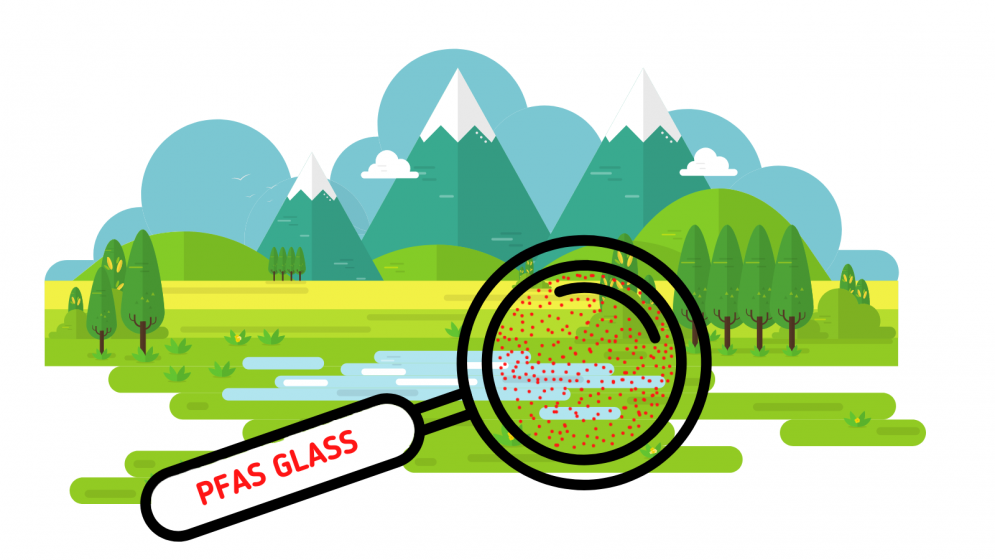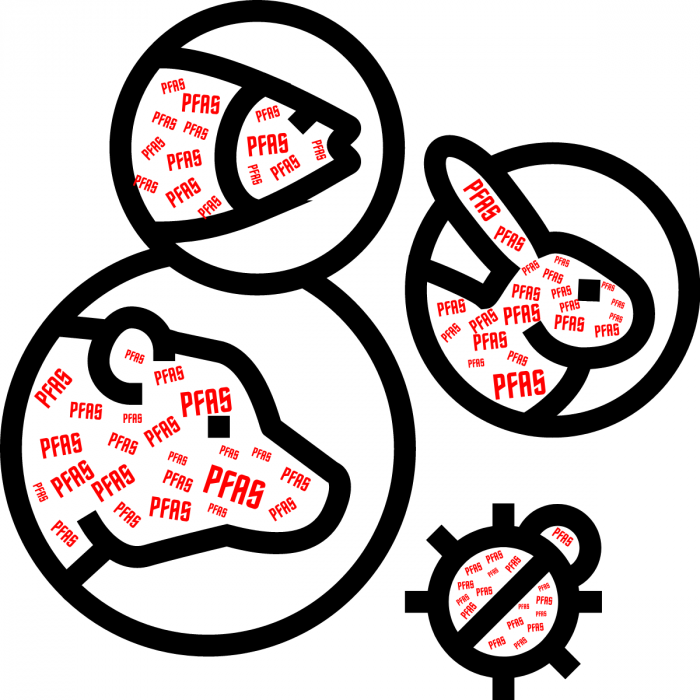A 2021 Environment Agency (EA) report1 highlights multiple gaps in the UK’s environmental monitoring for the group of chemicals known as poly- and per-fluoroalkyl substances (PFAS). Should we be concerned?
Pollution we can’t see
PFAS are a group of over 4,700 chemicals widely used since the 1940s in consumer items from waterproof clothing to personal care products. Like much chemical pollution, PFAS spread through our environment unseen, often unchecked. Few have been studied in depth, but those that have show significant toxicity. Extremely persistent in the environment, they are known as ‘Forever Chemicals’ and linked to many alarming health conditions.2
The UK currently only regulates two of over 4,700 PFAS: Perfluoro-octanoic Acid (PFOA) and Perfluoro-octane-sulphonate (PFOS). But what about the other 4,698? Some will have similar impacts, some worse – ‘GenX’ is another PFAS now known to be hazardous at lower exposures than PFOS and PFOA.3
PFAS in the environment
Once in the environment, PFAS are highly mobile and are found far from their original source.
Water
EA screening frequently detected PFAS in surface water samples, with PFOA and PFOS detected at 96 % of the sites sampled. Elevated PFAS levels mean 100% of England’s rivers fail the Water Framework Directive’s assessment of “good chemical status”.
Drinking water is a main source of exposure to PFAS.4 Water bodies being tested by the EA may be sources of drinking water or have drinking water going into them.
Air
Although PFAS are known to be released into the air from various sources and may travel significant distances to remote locations,5 the EA do not routinely sample for them. They may be inhaled directly, or ingested through contaminated food and water after deposition to ecosystems.6
Soil
Soil is not routinely monitored for PFAS either. The application of materials like sewage sludge to land as a route for PFAS into soil is poorly understood and a concerning gap. PFAS levels in sludges from wastewater treatment works (WWTW) are being measured through a current Chemicals Investigation Programme (CIP3).7
 Animals
Animals
The risk of animal exposure to PFAS is considerable due to the widespread contamination of the environment. PFAS are in marine birds,8 fish,9 harbour porpoise,10 and otters11. A broad range of PFAS are being recorded in the environment, including those introduced to replace the restricted PFOS and PFOA.
Food (and therefore humans)
Once in the environment, PFAS contaminate soil and water and enter the food chain. A recent large-scale human biomonitoring study found PFAS in the blood of teenagers in all nine European countries involved.12 Over 14 percent of the samples exceeded the health guidelines set by the European Food and Safety Authority, EFSA, with locally produced food having the highest impact on blood PFAS levels.
The UK does not currently regulate PFAS in food. This is under review following EFSA’s publication on safe food limits.13
PFAS monitoring in the UK
Extensive gaps are evident in the EA’s understanding of PFAS pollution in the UK, such as potential releases of PFAS during their life cycle, including recycling and waste disposal. Limited toxicological data for most PFAS pose a significant challenge for assessing the risk they pose.
Methods for detecting PFAS have not kept pace with shifts in chemical production since the voluntary phase-out of PFOS, PFOA and other legacy PFAS, which now represent only a small proportion of the total number of PFAS.14
The EA have identified additional monitoring programmes and projects (started in 2021) to expand its existing evidence base, to include:
- Groundwater
- Surface water (fresh and saline)
- Freshwater fish (PFOA and PFOS only)
- Marine fish
- Landfill leachate
- WWTW effluent and sludge (through CIP3)
What does this mean for the future?
A recent review suggests environmental levels of PFAS are not declining, even with some global production now limited.15 The ubiquity of PFAS in the environment and their presence in the human body underlines the urgency of a universal PFAS ban on non-essential uses.
The UK is awaiting the outcome of a PFAS regulatory management options analysis (RMOA), which will consider the best way to manage risks posed by PFAS (see blogs here and here). In the interim, Fidra recommend reducing personal exposure to PFAS wherever possible (see our website), and writing to your local representatives to highlight the urgent need for PFAS regulation.
Further Reading:
– British Geological Society (2018) Emerging contaminants in groundwater.
– Pan Y, et al. (2018). Worldwide Distribution of Novel Perfluoroether Carboxylic and Sulfonic Acids in Surface Water. Environ Sci Technol. 2018 Jul 17;52(14):7621-7629. doi: 10.1021/acs.est.8b00829. Epub 2018 May 11. PMID: 29749740.
− Environment Agency (2019). Perfluorooctane sulfonate (PFOS) and related substances: sources, pathways and environmental data.
References
[1] Environment Agency, (2021) Poly- and perfluoroalkyl substances (PFAS): sources, pathways and environmental data. Environment Agency, Britain.
[2] Fidra, (2019). PFAS, what is it, why is it in our environment and why is it a problem? [online] Available at: <https://www.pfasfree.org.uk/about-pfas> [Accessed 8 August 2022].
[3] US EPA. (2022). Human Health Toxicity Assessments for GenX Chemicals | US EPA. [online] Available at: <https://www.epa.gov/chemical-research/human-health-toxicity-assessments-genx-chemicals> [Accessed 3rd August 2022].
[4] Domingo, J. and Nadal, M., (2019). Human exposure to per- and polyfluoroalkyl substances (PFAS) through drinking water: A review of the recent scientific literature. Environmental Research, 177, p.108648.
[5] Garnett, J., Halsall, C., Winton, H., Joerss, H., Mulvaney, R., Ebinghaus, R., Frey, M., Jones, A., Leeson, A. and Wynn, P., (2022). Increasing Accumulation of Perfluorocarboxylate Contaminants Revealed in an Antarctic Firn Core (1958–2017). Environmental Science& Technology. DOI: 10.1021/acs.est.2c02592.
[6] D’Ambro, E. and Murphy, B., (2021). Modeling PFAS Air Emissions, Deposition, and Chemistry. Webinar
[7] Chemical investigations programme Data access portal. (2022). Chemical investigations programme Data access portal. [online] Available at: <https://ukwir.org/eng/sign-up-and-access-the-chemical-investigations-programme-data-access-portal> [Accessed 2 August 2022].
[8] Walker, L.A., Potter, P.E.D., Bruguera, S.L, Shore, R.F. (2015). Perfluorinated compound (PFC) concentrations in northern gannet eggs 1977-2014: a Predatory Bird Monitoring Scheme (PBMS) report. Centre for Ecology & Hydrology, Lancaster, UK. 18 pp. https://pbms.ceh.ac.uk/sites/default/files/PBMS_Gannet_PFCs_report_2013.pdf
[9] Fernandes, A.R. et al. (2018) Occurrence and spatial distribution of chemical contaminants in edible fish species collected from UK and proximate marine waters. Environmental International, 114, 219-230.
[10]Law, R. J. et al. (2008), PFOS and PFOA in the livers of harbour porpoises (Phocoena phocoena) stranded or bycaught around the UK. Marine Pollution Bulletin, 56, 792-797.
[11] O’Rourke, E. et al. (2022). Anthropogenic Drivers of Variation in Concentrations of Perfluoroalkyl Substances in Otters (Lutra lutra) from England and Wales. Environmental Science & Technology, 56(3), 1675-1687. DOI: 10.1021/acs.est.1c05410
[12] HBM4EU work on Per- and Polyfluroalkyl Substances (PFAS). https://www.hbm4eu.eu/wp-content/uploads/2018/12/HBM4EU_PFAS_brief_v2.pdf [Accessed: 8th August 2022]
[13] European Food Safety Authority. (2022) PFAS in food: EFSA assesses risks and sets tolerable intake. [online] Available at: <https://www.efsa.europa.eu/en/news/pfas-food-efsa-assesses-risks-and-sets-tolerable-intake> [Accessed 8 August 2022].
[14] De Silva, A. O. et al. (2021) ‘PFAS Exposure Pathways for Humans and Wildlife: A Synthesis of Current Knowledge and Key Gaps in Understanding’, Environmental Toxicology and Chemistry, 40(3), pp. 631–657. doi: 10.1002/ETC.4935.
[15] Land, M. et al. (2018) What is the effect of phasing out long-chain per- and polyfluoroalkyl substances on the concentrations of perfluoroalkyl acids and their precursors in the environment? A systematic review, Environmental Evidence. BioMed Central. doi: 10.1186/s13750-017-0114-y.
Tags: #Contamination, Chemical Pollution, Environment, PFAS

